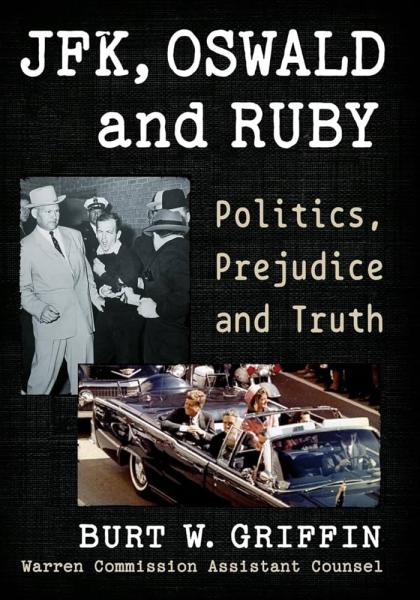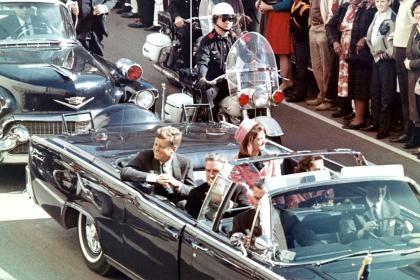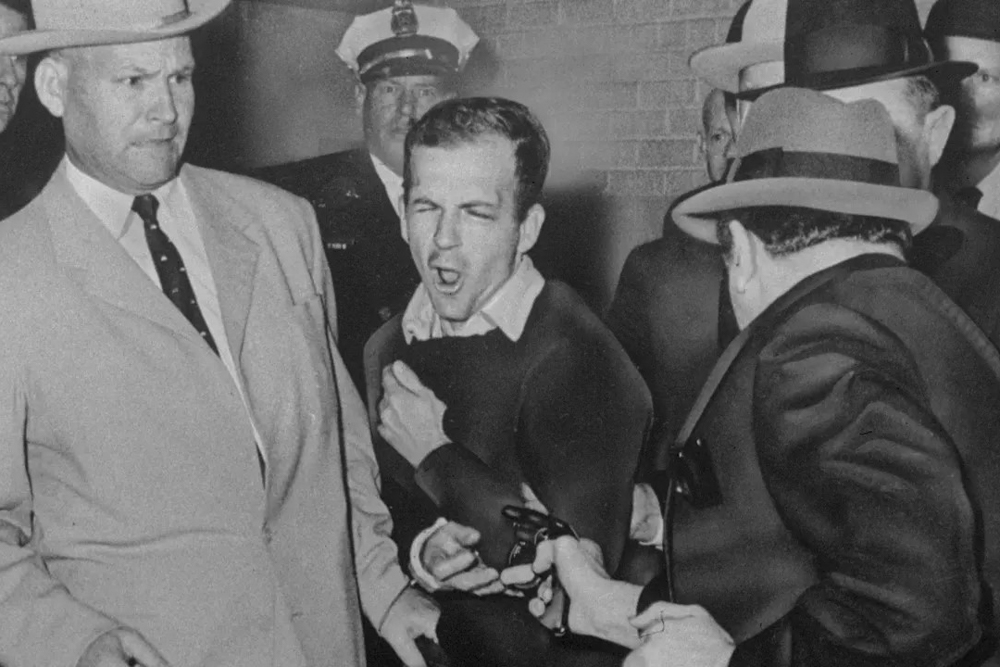Local author examines JFK assassination, conspiracy theories in ‘JFK, Oswald and Ruby’
People who lived through President John F. Kennedy’s assassination 60 years ago are still retelling and reinterpreting it while they can.
Burt W. Griffin, who worked as an attorney for the Warren Commission in the 1960s, and held other leadership roles in both Washington, D.C. and Cleveland over the decades, shares his conclusions about the 1963 assassination of President Kennedy, Lee Harvey Oswald’s involvement, Jack Ruby, and other political issues and figures of the era in his recently published book, “JFK, Oswald and Ruby: Politics, Prejudice and Truth.”
Griffin says he wants to debunk persistent claims of conspiracies behind perhaps the nation’s most investigated crimes: the killings of President Kennedy and Patrolman J.D. Tippit on Nov. 22, 1963; and the murder of their killer, Lee Harvey Oswald, two days later.
Griffin also explores something he says he considers more relevant: the personal and political conflicts that spurred Oswald to assassinate Kennedy and Jack Ruby to kill Oswald.
“There is no unsolved murder mystery in the Kennedy assassination,” says Griffin, best known locally for 30 years (1975-2005) as a Cuyahoga County Court of Common Pleas judge.
 JFK, Oswald and Ruby: Politics, Prejudice and Truth“There was no conspiracy,” Griffin says. “Oswald and Ruby did it acting completely alone.” Among the author’s many reasons, he says that Oswald was too much of a loner and both killers were too volatile for conspirators to work with.
JFK, Oswald and Ruby: Politics, Prejudice and Truth“There was no conspiracy,” Griffin says. “Oswald and Ruby did it acting completely alone.” Among the author’s many reasons, he says that Oswald was too much of a loner and both killers were too volatile for conspirators to work with.
Still, Griffin says, “Everyone loves mysteries.” Polls over the years have usually shown that most Americans suspect a conspiracy behind those bullets. He contends that some writers, lawyers, and officials have sown confusion for publicity and gain.
At 89, Griffin still climbs up and down his three-story Tudor in Shaker Heights, across from his former Boulevard Elementary School. He’s in the middle of a line of public servants. His father, Burt, was chief judge of Cleveland Municipal Court, then joined the Cuyahoga Common Pleas bench. His son, Mark, is Cleveland’s law director.
Griffin grew up in Cleveland; graduated from Shaker Heights High School, Amherst College, and Yale Law School; and spent two years in the U.S. Army—mostly at Fort Bliss in El Paso, Texas. His early jobs included U.S. Court of Appeals clerk in Washington, D.C., assistant U.S. attorney in Cleveland, head of the Legal Aid Society of Cleveland, and director of the federal Legal Services Program.
In late December of 1963, a Justice Department acquaintance recruited Griffin for the President’s Commission on the Assassination of President Kennedy (Warren Commission), chaired by U.S. Supreme Court Chief Justice Earl Warren.
Griffin became assistant counsel and spent most of the next eight months investigating Ruby. The lawyer couldn’t interview the strip-tease club owner because of his pending trial, but questioned police and federal agents about him.
“I made every effort to find evidence of Ruby’s involvement in a conspiracy,” Griffin recalls. “I found none.” He says that Ruby knew some police and mobsters but was no insider. Griffin came to accept Ruby’s statement about wanting to “show the world that a Jew had guts.”
 Griffin wants to debunk persistent claims of conspiracies behind perhaps the nation’s most investigated crimes: the killings of President KennedyRuby was Jewish and had changed his surname from Rubenstein. In Dallas that year, several Jewish homes and stores had been marked with swastikas. On the morning of Kennedy’s motorcade, the Dallas Morning News ran a black-bordered ad against the president signed by Bernard Weissman. Since that name sounded Jewish, Ruby feared that Jews would be blamed for the assassination.
Griffin wants to debunk persistent claims of conspiracies behind perhaps the nation’s most investigated crimes: the killings of President KennedyRuby was Jewish and had changed his surname from Rubenstein. In Dallas that year, several Jewish homes and stores had been marked with swastikas. On the morning of Kennedy’s motorcade, the Dallas Morning News ran a black-bordered ad against the president signed by Bernard Weissman. Since that name sounded Jewish, Ruby feared that Jews would be blamed for the assassination.
Griffin says he remains unsure whether police knowingly let Ruby enter their headquarters on Nov. 24. But Griffin says he’s sure they didn’t suspect that the visitor would shoot Oswald.
The book also explores Oswald’s troubled life: bouncing between jobs, homes, and two countries; plotting to hijack a plane to Cuba; and shooting retired General Edwin Walker—a vocal Dallas foe of Kennedy, integration, and Communism. It took the Warren Commission to detect Oswald’s role in Walker’s wounding.
Meanwhile, Griffin says, Oswald seems to have targeted Kennedy partly to foil the White House’s leaked plot to kill Cuban President Fidel Castro. Oswald also hoped that his own plot against Kennedy would be blamed on right-wingers.
Griffin criticizes several agencies’ actions before and after the killings. The CIA long hid its plots against Castro and other foreign leaders. The FBI destroyed a note from Oswald protesting its questioning of his wife and failed to alert other agencies about him.
Neither Oswald nor Ruby was found insane. But Griffin says that even the craziest people are somewhat aware of news and influenced by it.
“Politicians and the media must understand the weaknesses of their audience and the possible impact of their messages,” he writes in his book. “Leaders need to think about the risks they’re raising, not only for the country, but for themselves when they stir up passions in this country that can lead disturbed individuals like Ruby and Oswald to violence.”
In 1973, Griffin was invited to a local screening of the conspiracy-minded “Executive Action” by Harry Blum, a Shaker Heights High graduate and associate producer. On stage afterward, Griffin called the movie fiction.
Still, Griffin says he didn’t regret attending. A widower with two pre-teen boys, at the screening he met the woman who became his second wife. Today, Burt and Beatrice (Bunny) Griffin have been married for 48 years.
From 1974 to 2004, Griffin served in the Common Pleas Court. Among other accomplishments, he created a mental health docket and a gun education program. The Democrat never lost an election. He finally had to retire because of age.
 Lee Harvey Oswald is shot by Jack Ruby in a corridor of Dallas police headquartersIn 1977, Cleveland Congressman Louis Stokes chaired the House Select Committee on Assassinations, which voted that there had probably been a conspiracy to kill Kennedy. But Griffin says that the panel was misled by the recording of a supposed shot. A National Academy of Sciences panel later concluded that the sound happened at a different time and place than originally thought.
Lee Harvey Oswald is shot by Jack Ruby in a corridor of Dallas police headquartersIn 1977, Cleveland Congressman Louis Stokes chaired the House Select Committee on Assassinations, which voted that there had probably been a conspiracy to kill Kennedy. But Griffin says that the panel was misled by the recording of a supposed shot. A National Academy of Sciences panel later concluded that the sound happened at a different time and place than originally thought.
Well into retirement, Griffin helped Todd Kwait, then living in Shaker, now living in Cleveland Heights, make the 2019 assassination documentary, “Truth is the Only Client.” Griffin went to Michigan and California to interview people with pertinent information. He also started to write his own account.
The author got help from C. Ellen Connally, former Cleveland municipal judge and Cuyahoga County councilwoman, who collects Kennedy memorabilia.
Connally says of the book. “It’s very, very informative. It’s important because it shoots down so many of these conspiracy people.”
Another Shaker resident, former Secret Service agent Paul Landis, just published “The Final Witness.” During Kennedy’s motorcade, Landis was riding on the running board of the car right behind Kennedy’s. Landis’ book newly says that he found a spent bullet in Kennedy’s limo and put it on a stretcher in the hospital.
If true, the account challenges the official finding that the same bullet hit Kennedy and wounded a fellow passenger, Texas Governor John Connally (no known relation to Cleveland’s Connally). But Griffin doubts Landis’s claim and says that there’s no other evidence of a second shooter.
Shaker historian James D. Robenalt helped with Landis’ book and supports his account. But he also praises Griffin’s book for “keen insights” into the politics and prejudices behind the slayings. “It can only get worse if leaders do not stand up to the hatred and call it out,” he says.
Griffin says he hopes to follow up with a docudrama about the assassination. Meanwhile, he’s giving many talks about “JFK, Oswald and Ruby” both locally and around the country.
There’s no centralized schedule listed online for the talks. But one will take place on Sat., Oct. 28 at 1 p.m. at the Cleveland Public Library Hough Branch, 6530 Lexington Ave. Griffin will speak on Monday, Nov. 6 at Parnell’s Irish Pub, 12425 Cedar Road, Cleveland Heights, from 7 p.m. to 9 p.m.
This article has been archived for your research. The original version from Google News can be found here.


